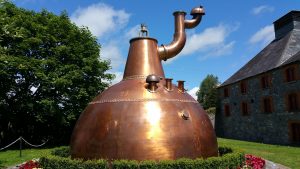
The first record of Irish whiskey goes back to 1405. For several hundred years, distilling whiskey was solely a private affair in Ireland, with people distilling the spirit at home. In 1608 the first license to distill whiskey was issued to landowner and Governor of County Antrim, Sir Thomas Phillips. Old Bushmills Distillery, registered in 1784, is still in operation today in Northern Ireland. In 1781, the government of the United Kingdom outlawed private distilling operations. By the late 18th century around 2,000 stills were thought to be in existence, with two-thirds of the output coming from illegal stills. By 1885, twenty-eight legal distilling businesses were operating. Before Prohibition, Irish whiskey was the most popular form of whiskey consumed in the United States. Interest waned after that and by the latter half of the 20th century, only two distilleries remained in operation. But, more recently its popularity has seen a resurgence in the United States and around the world.
In order to be called Irish whiskey, production of the beverage must adhere to regulations drafted in 1980. The whiskey must be made in Ireland from a mash of malt and cereals, not contain additives except water and caramel coloring, retain the taste and smell of whiskey and be bottled with no less than 40% alcohol by volume. Irish whiskey malt is dried in a closed kiln, away from fire and smoke. Traditionally, the whiskey is triple distilled in copper pot stills1 and by law must be aged for at least three years in wooden barrels, often in used bourbon barrels or wine casks.
Today’s market size shows the U.S. suppliers’ annual gross revenue of Irish whiskey in 2003 and 2018, a more than 1,200% increase. In 2018, Irish whiskey accounted for 60% of all beverages exported to the United States from Ireland. The United States was the largest market, valued at more than €340 million, a 9% increase from 2017. Around the world, Ireland saw double-digit increases of exports to Central and South America (+42%), Australia and the South Pacific (+36%), the United Kingdom (+25%), the European Union (+16%), and Africa (+15%) from 2017 to 2018. As of May 2018, there were 18 licensed whiskey distilleries in Ireland producing an estimated 175 brands.
Sláinte!
1 Modern Irish distilleries use column stills for grain and blended whiskey. Pot stills are used for high-quality malt whiskey.
Geographic reference: United StatesYear: 2003 and 2018
Market size: $75 million and $1 billion, respectively
Sources: “USA Snapshots: Irish Whiskey Generates $1 Billion,” USA Today, March 13, 2019, page 1A; “The History” available online here; Kate Phelan, “A Brief History of Irish Whiskey,” Culture Trip, June 26, 2018 available online here; Lance Mayhew, “Irish Whiskey Basics,” The Spruce Eats, April 4, 2018 available online here; Colleen Graham, “Your Complete Guide to Whiskey Styles,” The Spruce Eats, March 23, 2018 available online here; Export Performance and Prospects 2018-2019, Bord Bia available online here; Liam Campbell, “The New and Soon to Open Irish Whiskey Distilleries You Need to Know About,” The Taste, May 4, 2018 available online here; “The Bushmills History” available online here; Jonny McCormick, “This is a Golden Age for Irish Whiskey Blends,” Whiskey Advocate, February 4, 2019 available online here; “Instant Expert: Irish Whiskey,” Whiskey Advocate, March 22, 2017 available online here; “Irish Whiskey Distillation,” Whiskey.com available online here.
Original source: Distilled Spirits Council
Image source: Richard Mcall, “whiskey-brewing-copper-kettle-2554629,” Pixabay, July 30, 2017 available online here.
